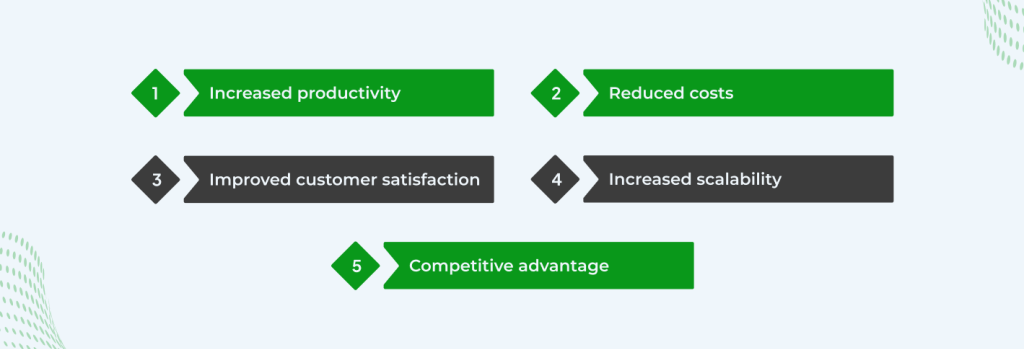A study by Deloitte found that companies that implemented warehouse management systems saw an average increase in productivity of 15%. Custom Warehouse Management Systems (WMS) are software and process systems that help companies manage their warehouse operations from receiving to shipping. Custom warehouse management system solutions tailor inventory tracking, order fulfilment, and task automation to your business’s unique needs and goals, driving efficiency and accuracy.
Warehouse management systems can be as simple as a standalone spreadsheet or as complex as an integrated system that ties into all aspects of the supply chain. For example, a 3PL (third-party logistics) company might use a WMS system to manage its warehouse operations, including receiving, picking, packing, and shipping. The WMS system would be integrated with the company’s transportation management system (TMS) to optimize shipping routes and costs.
WMS systems can also be integrated with other systems, such as manufacturing execution systems (MES) and customer relationship management (CRM) systems. This integration allows companies to share data across their systems and improve visibility into their supply chains.
A custom warehouse management system is designed specifically for the unique needs of a business, allowing for a customised solution that aligns with its processes and requirements. By integrating various functionalities such as inventory management, order fulfilment, and supply chain optimization, a WMS enables businesses to improve overall productivity, enhance accuracy, and meet customer demands in a timely manner.
With the ever-increasing complexity of supply chains and the growing need for real-time data, having a custom warehouse management system in place can significantly transform a company’s operations. From reducing manual labour and administrative tasks to improving inventory accuracy and order fulfilment rates, the benefits of implementing a WMS are undeniable.
In this blog, we will delve into the power of how a custom-made warehouse management system lies in its ability to maximize productivity and minimize errors. By investing in a WMS that meets your specific needs, businesses can enhance efficiency, reduce costs, and gain a competitive edge in the market.
The Role Of a Warehouse Management System In Improving Productivity
A warehouse management system is a software application that helps businesses manage and optimize their warehouse operations. A WMS provides real-time visibility into inventory levels, locations, and movements, enabling businesses to make data-driven decisions and respond quickly to changing customer demands. It also helps automate many manual tasks, reducing the risk of errors and improving overall productivity.
One of the primary benefits of a WMS is its ability to streamline and optimize warehouse workflows. By automating processes such as receiving, putaway, picking, and shipping, a WMS can significantly reduce the time it takes to complete these tasks. This not only increases productivity but also reduces the risk of errors and improves order accuracy.
Another key benefit of a WMS is its ability to provide real-time data and insights into warehouse operations. With a WMS, businesses can track inventory levels, monitor order status, and identify bottlenecks in the warehouse. This data can be used to make informed decisions and optimize warehouse operations for maximum efficiency.
Common Errors In Warehouse Management and Their Impact On Operations
Without a WMS in place, warehouse management can be prone to errors that can have a significant impact on operations. Some of the most common errors include incorrect inventory counts, misplaced items, and inefficient workflows.
Incorrect inventory counts can lead to stockouts or overstocking, both of which can have a negative impact on customer satisfaction and profitability. Misplaced items can cause delays in order fulfilment and increase the risk of errors. Inefficient workflows can result in wasted time and resources, reducing overall productivity.
These errors can be costly for businesses, both in terms of time and money. Inaccurate inventory counts can lead to lost sales, while misplaced items can result in additional labour costs and delays in order fulfilment. Inefficient workflows can also result in increased labour costs and reduced productivity.
Benefits Of a Tailor-made WMS For Your Business

A tailor-made WMS is designed specifically for the unique needs of a business, allowing for a customized solution that aligns with its processes and requirements. By integrating various functionalities such as inventory management, order fulfilment, and supply chain optimization, a custom warehouse management system enables businesses to improve overall productivity, enhance accuracy, and meet customer demands in a timely manner.
One of the primary benefits of a tailor-made WMS is its ability to align with a business’s specific workflows and processes. This ensures that the WMS is optimized for maximum efficiency and productivity, reducing the risk of errors and improving overall accuracy.
Another benefit of a tailor-made WMS is its ability to provide real-time visibility into inventory levels and order status. This data can be used to make informed decisions and optimize warehouse operations for maximum efficiency.
A tailor-made WMS can also help businesses reduce costs by automating manual tasks and optimizing workflows. This not only reduces the risk of errors but also improves overall productivity and reduces labour costs.
WMS can track and measure employee productivity, identifying bottlenecks and areas where efficiency can be improved. This data can be used to optimize warehouse layout, workflow, and training programs. WMS can also automatically assign tasks to employees based on their skills and experience, minimizing indirect activities and non-value-added work.
By providing real-time visibility into labour performance, WMS can help warehouse managers forecast and plan labour requirements more accurately. This leads to better scheduling and ensures that the right people are in the right place at the right time.
WMS integrates data from multiple sources to identify inefficient processes or areas where employees may be struggling. This information can be used to make targeted improvements to warehouse operations, leading to faster order fulfilment and improved customer satisfaction.
Key Features To Consider When Building A Warehouse Management System

While building a WMS, there are several key features to consider. These include:
1. Inventory management
A WMS should be able to track inventory levels, locations, and movements in real-time.
2. Order Fulfilment
A WMS should be able to automate processes such as picking, packing, and shipping to improve order accuracy and reduce fulfilment times.
3. Supply Chain Optimization
A WMS should be able to provide real-time data and insights into supply chain operations, enabling businesses to optimize workflows and reduce costs.
4. Customization
A WMS should be able to be tailored to the unique needs of a business for maximum efficiency and productivity.
5. Integration
A WMS should be able to integrate with other systems such as ERP and CRM for seamless operations.
Steps To Implement A Tailor-Made WMS
Implementing a tailor-made WMS can be a complex process, but there are several key steps that businesses can take to ensure a successful implementation. These steps include:
1. Conduct a needs assessment
Before implementing a WMS, businesses should conduct a needs assessment to identify their specific requirements and processes.
2. Customize The WMS
The WMS should be customized to align with the business’s specific workflows and processes for maximum efficiency and productivity.
3. Onboard and Train Employees
Employees should be onboarded and trained on the new WMS to ensure a smooth transition and minimize errors.
4. Test and refine
The WMS should be tested and refined to ensure that it is optimized for maximum efficiency and productivity.
5. Training and onboarding employees on the new WMS
Training and onboarding employees on the new WMS is essential to ensure a smooth transition and minimize errors. Employees should be trained on the new system’s functionalities and workflows.
Integrating a WMS With Other Systems For Seamless Operations
Integrating a WMS with other systems such as ERP and CRM can help businesses achieve seamless operations and improve overall efficiency. By integrating these systems, businesses can automate processes such as order entry and invoicing, reducing the risk of errors and improving overall accuracy.
Measuring the success of a tailor-made WMS through key performance indicators (KPIs)
Measuring the success of a tailor-made WMS is essential to ensure that it is delivering the expected benefits. Key performance indicators (KPIs) such as order fulfilment rates, inventory accuracy, and labour costs can be used to track the WMS’s performance and identify areas for improvement.
Businesses should regularly monitor these KPIs and make adjustments to the WMS as needed to ensure that it is optimized for maximum efficiency and productivity.
Final Thoughts
In conclusion, a custom warehouse management system is a powerful tool that can help your business maximize productivity and minimize errors. By providing real-time visibility into inventory levels, automating manual tasks, and optimizing workflows, a WMS can significantly transform a company’s operations.
As supply chains become increasingly complex and the need for real-time data grows, the demand for WMS solutions will continue to increase. By choosing a company that specializes in implementing custom warehouse management solutions and following the key steps outlined in this article, businesses can successfully implement a WMS that aligns with their specific needs and requirements.
Confused about how to develop a custom warehouse management solution for your business?
Aipxperts is a leading provider of custom warehouse management solutions. We have a team of experienced professionals who can help you assess your needs, design a solution that meets your unique requirements, and implement the system efficiently and effectively.
We offer a wide range of WMS features and functionality, including:
- Real-time inventory tracking
- Order management
- Warehouse automation
- Labor management
- Reporting and analytics
We can also integrate your WMS with other systems, such as your ERP system, transportation management system, and e-commerce platform.
Here are just a few of the benefits of contacting Aipxperts for your warehouse system requirements:
- We have a proven track record of success in implementing WMS solutions for businesses of all sizes and industries.
- We offer a wide range of features and functionality to meet your specific needs.
- We can integrate your WMS with other systems to create a seamless solution.
- We provide comprehensive support and training to help you get the most out of your WMS.
If you are ready to take your warehouse operations to the next level, contact Aipxperts today for a free consultation. We will help you choose the right WMS solution for your business and implement it successfully.
Take a look at our portfolio and explore the warehousing management application that we have developed here.











